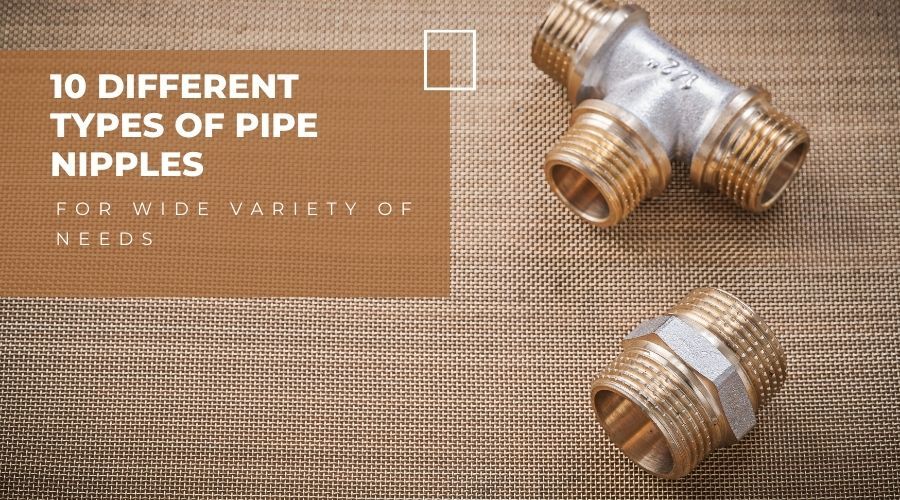
Regarding plumbing systems, pipe nipples play a crucial role in connecting pipes and facilitating fluid flow. These small yet significant components are available in various types and variations, each designed to meet specific requirements. Whether you're a DIY enthusiast or a professional plumber, understanding the different types of pipe nipples can significantly enhance your plumbing projects. We will delve into 10 different pipe nipple varieties, discussing their features, applications, and advantages.

Threaded nipples are one of the most common and versatile types of pipe nipples. They feature external threads on both ends, allowing easy connection with threaded fittings or pipes. Key features of threaded nipples include:
• Ideal for joining two female-threaded pipes or fittings securely.
• Available in various lengths, sizes and diameters to accommodate different plumbing needs.
• Can be made from different types of raw materials such as brass, stainless steel, or galvanized steel.

Ready-cut pipe nipples, as the name suggests, come pre-cut to standard lengths. These convenient pipe nipples offer the following advantages:
• Saves time and effort by removing the requirement for manual cutting.
• Ensures accurate and consistent pipe lengths, promoting seamless connections.
• Suitable for both residential and commercial plumbing applications.

Weld nipples are designed explicitly for welding purposes. They have one threaded end and one plain end, allowing easy connection to threaded fittings while providing a smooth surface for welding. Key characteristics of weld nipples include:
• Designed for permanent connections through welding techniques like arc welding or TIG welding.
• Commonly used in industrial applications that require robust and leak-free joints.
• Available in various materials, including carbon steel, stainless steel, and copper.

Close nipples are short pipe nipples with both ends threaded fully. These nipples have the following features:
• Designed for tight spaces where minimal extension is required.
• Allows pipes to be connected closely, reducing the overall length.
• Offers a secure and compact connection without compromising strength.

Hex nipples, or hexagonal nipples, are distinguished by their hexagonal middle section. Here are some notable features of hex nipples:
• The hex shape allows for easy installation and removal with a wrench or a socket.
• Ideal for applications where a secure connection is necessary, such as high-pressure systems.
• Available in various materials, including brass, stainless steel, and nickel-plated steel.

Swage nipples, also called reducing nipples, are used to transition between two pipes of different sizes. These nipples offer the following advantages:
• Helps connect pipes with different diameters while maintaining a smooth flow transition.
• Reduces the need for additional fittings and simplifies the plumbing assembly.
• Commonly used in oil, gas, and chemical industries, as well as in plumbing systems with varying pipe sizes.

Seamless pipe nipples are manufactured from a single piece of material, ensuring a continuous and smooth interior surface. Key features of seamless pipe nipples include:
• Minimizes friction and pressure drop within the pipe, enhancing fluid flow efficiency.
• Offers superior strength and durability due to the absence of welded seams.
• Suitable for applications that require high corrosion resistance and clean flow channels.

Grooved pipe nipples feature grooves on both ends, enabling quick and secure installation with grooved pipe couplings. These nipples have the following characteristics:
• Designed for easy assembly and disassembly, making them ideal for systems requiring frequent maintenance.
• Provides a reliable and leak-resistant connection, even in high-pressure environments.
• Commonly used in fire protection systems, HVAC installations, and industrial piping.

Combination nipples, also known as hose nipples, are versatile pipe nipples that allow direct connection with hoses or tubes. Here's what you need to know about combination nipples:
• Features barbed ends that provide a secure grip on the hose, preventing leaks and disconnections.
• Suitable for various applications, including fluid transfer, irrigation systems, and pneumatic installations.
• Available in different materials and sizes to accommodate specific hose and tubing requirements.

Male adapters, also called male thread adapters, enable the connection between female-threaded pipes or fittings. These adapters possess the following characteristics:
• Equipped with male threads on one end and either a plain end or female threads on the other.
• Provides flexibility in connecting pipes with different thread types or sizes.
• Widely used in plumbing, irrigation, and industrial applications for joining various components.
In the world of plumbing, pipe nipples are essential components that enable the seamless flow of fluids. Understanding the different types of pipe nipples, such as threaded, ready-cut, weld, close, hex, swage, seamless, grooved, combination, and male adapters, empowers you to make informed decisions for your plumbing projects. By choosing the right pipe nipple, you can ensure secure connections, efficient flow, and reliable performance. So, explore the diverse range of pipe nipple options, consider your specific plumbing needs, and confidently embark on your plumbing projects.
Remember, whether connecting pipes in a residential plumbing system or setting up an intricate industrial network, the right pipe nipple can make all the difference!
Question 1: Which material is best for pipe nipples?
Answer 1: The choice of material depends on factors such as application, transport fluid, and environmental conditions. Common materials include brass, stainless steel, galvanized steel, and copper.
Question 2: Can pipe nipples be used for gas lines?
Answer 2: Yes, pipe nipples can be used for gas lines. However, it is crucial to ensure the nipples and fittings are rated for gas applications and comply with local building codes and regulations.
Question 3: How do I choose the right pipe nipple for my project?
Answer 3: Consider factors such as material compatibility, pipe size, thread type, and the specific requirements of your plumbing system. Consulting with a professional plumber can also provide valuable guidance.